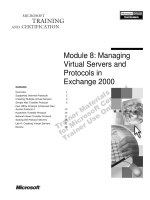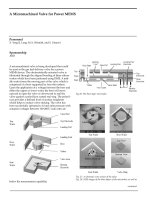Tài liệu ORGANIZING FOR CHANGE PROFESSION Integrating architectural thinking in other fields doc
Bạn đang xem bản rút gọn của tài liệu. Xem và tải ngay bản đầy đủ của tài liệu tại đây (10.55 MB, 286 trang )
MICHAEL SHAMIYEH <
and DOM Research Laboratory (Ed.)
ORGANIZING
FOR
/CHANGE
PROFESSION
Integrating architectural
thinking in other fi elds
Birkhäuser – Publishers for Architecture
Basel | Boston | Berlin
Editor
Michael Shamiyeh
Copy Editing
Kelly Klingler
Design
Reklamebüro Linz/Austria
A CIP catalogue record for this book is available from the
Library of Congress, Washington D.C., USA
Bibliographic information published by Die Deutsche Bibli-
othek Die Deutsche Bibliothek lists this publication in the
Deutsche Nationalbibliografie; Detailed bibliographic data is
available in the Internet at .
This work is subject to copyright. All rights are reserved,
whether the whole or part of the material is concerned, spe-
cifically the rights of translation, reprinting, re-use of illust-
rations, recitation, broadcasting, reproduction on microfilms
or in other ways, and storage in data banks. For any kind of
use, permission of the copyright owner must be obtained.
© 2007 Birkhäuser – Publishers for Architecture,
P.O.Box 133, CH-4010 Basel, Switzerland
Part of Springer Science+Business Media
Printed on acid-free paper produced from
chlorine-free pulp. TCF ∞
Printed in Germany
ISBN-10: 3-7643-7809-3
ISBN-13: 978-3-7643-7809-7
Despite intensive research efforts it was not possible to identify the copyright
holders in all cases. Justifiable claims will be honoured within the parameters
of customary agreements.
9 8 7 6 5 4 3 2 1
2
Michael Shamiyeh
Architect in practice and head of Design-Organisation-Media
Research Laboratory. Graduated with distinction as an archi-
tect from the Technical University of Vienna and has a Master
in Architecture from Harvard University Graduate School of
Design. He has done extensive research work in Jerusalem
and Berlin. Together with the cultural theorist Thomas Duschl-
bauer he is co-founder of the interdisciplinary Bureau for
Architec ture, Urbanism and Culture (BAU|KULTUR) that
seeks to define new relationships – as much theoretical as
practical – between a contemporary architectural produc-
tion and a con temporary cultural situation. Thus, the firm is
concerned with realising projects at home and abroad, tea-
ching, con sulting and investigation of cultural phenomena.
Design Organisation Media Research Laboratory (DOM)
DOM is based at The University of Arts and Industrial Design
and run in close collaboration with the Ars Electronica Cen-
ter, Linz. Point of departure for DOM is the assumption that
contemporary societal and technical changes have led to
new conclusions in the field of urbanism, architec ture and
design. As a sort of independent Think Tank DOM attempts
to help organisations to innovate, to define early relevant
topics, to show the need for action, and to formulate a set of
future actions. For this purpose DOM closely operates with
other institutions and experts at home and abroad, and orga-
nises international conferences and workshops.
In presenting the results of investigations in a clear and un-
derstandable way DOM intends to bring in lasting im pulses
and fundamentals for (public) debate.
3
4
5
TABLE OF CONTENTS <
2 <
6 <
8 <
12 <
16 <
18 <
34 <
50 <
54 <
58 <
70 <
84 <
90 <
98 <
114 <
116 <
124 <
Imprint <
Acknowledgement <
Foreword <
Speakers <
BUSINESS MEETS DESIGN
Introduction < Robert Bauer
Peter Senge < Adaptive Environments Emerge and Digitization Takes Command
Robert Bauer < Organizations as Orientation Systems – Some Remarks on
the Aesthetic Dimension of Organizational Design
INTERACT OR DIE
Introduction < Ole Bouman
Scott Lash < Paris/Shanghai
Michael Kieslinger < Designing the Flow of People and Organisations
Scott Lash < Intensive Media: Modernity and Algorithm
Marko Ahtisaari < Blogging over Las Vegas
Ole Bouman < A new Brief for Architecture
Thomas Duschlbauer/Michael Shamiyeh < AMO Experience
DESIGNING COMMUNICATIONS
Introduction < Thomas Duschlbauer
Norbert Bolz < The Design of Communication
Thomas Duschlbauer < Everlasting Change
Afterword < see reverse part
6
Organizing for Change is the third book on a series of DOM
conferences that began with an idea in 2002 to establish
architecture as the host of a cross-cultural and multi-
disciplinary discussion of architecture and contemporary
culture. It was never spoken publicly but primary intention
of organizing those conferences was to start a process of
rethinking the legitimacy of architecture and to discover
another kind of architecture. Accordingly, the objective of
those conferences was a) to investigate on different levels
some of the effects of Western societies and market eco-
nomy on architecture and on the architects in particular, b)
to question how architects justify their creative activities
to society, and c) to identify possibilities to actively apply
core competencies of our profession in other areas of life.
In preparing the book on the subject of the 3rd Conference
I got the strong conviction that we have made a substantial
step in this process – a step which would not been possible
without the great participation and support of a multitude of
institutions, sponsors, hosts, and of course, ambitious archi-
tects, designers, theorists, historians, artists, philosophers,
cultural theorists, economists and many others, who shared
their work and ideas in discussions and books like this one,
giving content and meaning to the project. Many thanks to
all of you! Without your engagement and tireless support,
neither DOM nor the conferences, and subsequently this
book, would exist.
In particular I would like to mention my mentor and indefa-
tigable rector of the University of Arts and Industrial Design,
Reinhard Kannonier, who has to be thanked for his long
lasting trust and support in this challenging endeavor. I also
thank Gerfried Stocker, director of the collaborating Ars
Electronica Center, who from the first day on helped to make
DOM happen and supported it with his crew.
A great dept of gratitude I owe to my colleague and cultural
theorist Thomas Duschlbauer as well as Christian Pressl-
mayer, who – coming from the field of economics – helped
me to get deeper insights on system thinking and organiza-
tional theories. Due to their commitment, intelligence and
knowledge of this subject, they had a great impact on the
development and success of DOM3.
The extraordinarily ambitious crew of AEC, in particular Kat-
rin Emler, Ellen Fethke, Elisabeth Sachsenhofer, and Manu-
ela Pfaffenberger assumed the fiscal responsibilities for the
conferences and provided valuable expertise in managing
them. Furthermore, I wish thank the following staff members
of the University of Arts and Industrial Design Linz as well as
of the AEC for their great support: Gregor Traugott for main-
taining each year’s website; Siglinde Lang for her support in
press and communications agendas; Karl Schmidinger and
Magnus Hofmüller for their technical support and last but
not least Irene Roselstorfer, who assisted me in the produc-
tion of this book.
Ulrike Ruh of Birkhaeuser Publishers deserves special
thanks as she has helped again to bring the discussed sub-
ject to the attention of an international audience by publi-
shing this book. Claus Zerenko, director of Reklamebüro, and
his staff members successfully managed the book’s layout
for the third time with great conviction. Mel Greenwald, a
reliable contributor to DOM since the first days, translated
again most of the German written articles.
Above all, one is constantly mindful of the generous con-
fidence displayed by the State Secretary for the Arts and
Media of the Federal Chancellery of Austria and the govern-
ments of the Province of Upper Austrian and the City of Linz
who, since the beginning of DOM, have provided grants to
help support the conferences and subsequently this publica-
tion. Lastly, the greatest contribution, the one for which I am
most grateful, is the unwavering support of all the authors
whose work appears in the following pages. Without their
extraordinary commitment and energy, the project would not
be as exciting and interesting as it is now.
Michael Shamiyeh
7
ACKNOWLEDGEMENT <
8
9
FOREWORD <
In the ‘90s, it became abundantly clear that globalization
was triggering substantial changes in the fi eld of
architecture too. Previous DOM conferences sought to
elaborate on them on a number of levels with the aim of
yielding insights applicable to architecture as practiced in
this day and age. The “Organizing for Change” conference
constituted an effort to come to terms with this wide-
ranging transformation. After all, at this point, particularly
acute powers of comprehension are hardly called for to
recognize the breathtaking speed with which the framework
conditions
– AND ESPECIALLY THOSE THAT
IMPACT ARCHITECTURE –
are changing under the infl uence of the manic cycles of the
market economy and intensifying mediatization.
The following focal-point issues were discussed in this
connection:
First off, that it simply takes too long to bring an architectural
project from conception to fruition. As is patently obvious,
the realization process of a major piece of construction now
lasts several years. In stark contrast to this, however, there
are hardly any political or economic factors that, after having
served as the bases of architectural decisions, have not
changed – and radically so – over this same length of time.
In other words, we are confronted today by the paradox that
the slowness of architecture has been left in the dust by the
changes that all political or economic initiatives have been
undergoing. The bottom line: architecture is in a certain
sense too slow to be able to effectively participate in what is
going on around it.
What’s more – and this is indirectly connected with the
fi rst point – it is increasingly clear that the static character
of architecture is sharply at odds with rapid changes and
developments in the market economy. No sooner is a
building completed than it is outed as already obsolete. Thus,
one can nowadays proceed under the assumption that the
design of cities goes hand in hand with the design of their
decay. Also (digital) media’s penetration into and saturation
of every aspect of our lives – together with the dissolution of
physical boundaries that is associated with this phenomenon
– massively calls into question one of architecture’s most
elemental concepts: namely, either to bring people together
physically or to physically separate them.
Isn’t it typical that just as architecture’s legitimation seems
to be on the wane, the term “architecture” has become
one of the most frequently employed metaphors for the
organizational structures of all aspects of life? Consider, for
example, buzzwords like systems architecture, corporate
organizational architecture, etc. Whereas architects deal
solely with the design of physical structures, the rest of the
world speaks of architecture as if it were a medium in which
the essence of all types of organizations and structures
manifests itself.
Paradoxically, we architects cannot participate in
this process. The reason for this is apparently simple
to explain: All that we have ever learned has been to
translate the organizational formulations that we have
come up with – for instance, the organization of functions
– into physical-material forms. This means that the most
fundamentally defi nitive values of our discipline have made
it incumbent upon us to react in the form of an architectural
structure instead of inquiring into the extent to which
the organizational structures that we create might also
be feasible in some other form or even applicable to and
utilizable in other spheres of life.
THIS SEEMS TO BE PRECISELY
THE PROBLEM OF ARCHITECTURE
THESE DAYS.
Therefore, it is up to us to assess the extent to which
architectural thinking can also be applied to other areas in
order to thereby perhaps succeed in making the transition
from an architecture of form to the architecture of
organization.
The following specialized fi elds and issues occupied the
focal point of our analyses:
Business Meets Design
Stirrings of great interest in design are evident throughout
the US economy at present, whereby what is at the
core of this interest is not so much the realization that
dawned in the 1990s that design plays not an insignifi cant
10
role in net value added to the economy as a whole but
rather the recognition that our world – and our business
enterprises and organizations in particular – should not
be regarded as something static but as a living system.
The rapid transformation process that has been taking
place worldwide thus necessitates that we pursue lifelong
learning in order to adapt to and successfully deal with
constantly emerging changes. In fact, many managers have
come to regard the way that designers go about their tasks
– PROCEEDING IN A MODE THAT
IS CREATIVE AND PRAGMATIC IN
EQUAL MEASURE –
as a very promising approach to effectively confronting a
wide variety of problems. According to this view, planning
and strategic processes should be reformulated as design
processes and managers converted from administrators to
business designers.
Interact Or Die
The rules governing the way things work in the media
nowadays and the associated intensifi cation of the
mediatization of all aspects of our lives raises the issue
of how to adequately design the fl ows and activities of
human beings and organizations. Since time immemorial,
architecture – due to its material presence – has either
brought elements together or separated them from each
other. But now that media have fundamentally modifi ed
the very concepts of fusion and partition, the question
that increasingly insinuates itself into the spotlight of our
attention is whether or not architecture must, in response,
revise its own core values and essential concepts.
Then, the issue would no longer be the accommodation
or implementation of programs and how these might be
experienced, but rather the design of fl exible organizations,
and thus no longer design concentrating on form but the
design of processes.
Designing Communication
The EU’s wish to establish itself more solidly in the
perception of its citizens as well as to achieve increased
visibility as the center of change and the accompanying
commissioning of architect Rem Koolhaas/ AMO to design
a new graphical language, a new symbolic vocabulary
for the EU constitutes a striking illustration of how the
architect’s sphere of activity can undergo a substantial
shift nowadays. For many Europeans, the EU exists solely
as abstract fl ows of funds and streams of data, as a market
and a media-based reality, which is why it is thoroughly
justifi able to speak of the Union’s identity problem. The
vision of a future Europe that Rem Koolhaas/ AMO came up
with revealed architecture’s great potential in this context:
the capacity to offer intelligent strategic approaches and, in
doing so, to design a cultural concept.
Positions of Neo-realism
Architecture has always had to do with the design and
organization of physical spaces. Even if steadfastly
upholding architecture’s most fundamental values prevents
the discovery of another type of architecture – since, after
all, if everything is architecture or architectural, then we
can expand our sphere of activities without any restrictions
whatsoever – erecting physical structures will nevertheless
remain an essential aspect of the architectural domain. The
question that then arises is, on one hand, how the architect
operatively faces the problem of the metamorphosis of
reality and on the other hand, how the constructed reality
permits or even furthers the emergence of changes.
Numerous models of operative activity are under
discussion, ranging from total rejection of a particular
assignment
– IN THIS MODEL, THE PROJECT
REMAINS UNREALIZED BUT RE-
MAINS DISCURSIVELY IN PLAY AND
THEREBY LEADS TO CHANGES –
and reprogramming all the way to the organization of
unsolicited interventions or “event structures” in space and
time.
Considering architecture in the context of the massive
changes currently taking place reveals that our profession
is more reactionary and conservative than the rest of
the world might suspect. Accordingly, the challenge that
11
architects today ought to – or perhaps even have to – face
involves questioning the defi nitions of our profession. It is
essential to ask which skills or what bodies of knowledge
are – or could be – inherent to architecture; how we could
go about legitimating ourselves to society on the basis of
these capabilities and insights; and which possibilities exist
to apply these skills and this knowledge in other areas too.
THIS BOOK REPRESENTS THE
EFFORT TO CONTRIBUTE TO THIS
IN A WAY THAT IS INTERESTING
AND INTERDISCIPLINARY.
As dictated by the theme itself, this volume has been
intentionally divided into two interrelated domains
that deliver insightful refl ections of one another. The
PROFESSION section focuses on the change or even
transformation of the profession into other fi elds; the
SPACE section sheds light on operative and architectural
strategies, and elaborates on concrete fi ndings and
insights that have emerged from dealing with change.
Thus, depending on the reader’s interest, each section
constitutes a discrete entity that can be read independently
of the other.
Michael Shamiyeh
12
13
SPEAKERS <
Marko Ahtisaari < Marko Ahtisaari is Director of Design Strategy at Nokia, a
world leader in mobile communications. Prior to this role Ahtisaari worked in the
Insight & Foresight, Corporate Strategy unit at Nokia where he was responsible
for identifying and driving new growth opportunities based on user experience.
Born in Helsinki, Finland and raised on three continents in Helsinki, Dar es
Salaam and New York, Ahtisaari studied economics, philosophy and music
at Columbia University in the City of New York where he went on to become
a popular lecturer. Prior to joining Nokia, Ahtisaari built and lead the mobile
practice at startup design consultancy Satama Interactive. He is a founder and
chairman of the board of Aula, a network of technologists, designers, artists,
entrepreneurs, researchers and civil society actors with the goal of creating
innovations for a better mobile life. Ahtisaari is a recognized thought leader on
the future of user experience and mobile culture. In the in-between moments he
continues to compose ambient music for public and private spaces.
Robert Bauer
< Robert M. Bauer is Associate Professor of Organizational Design
at Johannes Kepler University Linz, Austria. Currently he is a Visiting Professor
at the Joseph L. Rotman School of Management, University of Toronto. His
research aims at a better understanding of different ways of knowing, including,
but not limited to, formal and every day language statements. He explores the
consequences of different epistemological modes for organizational design
and behavior as well as for the philosophy of organization science. He is also a
registered psychotherapist and has worked extensively as an executive coach
and management consultant.
Norbert Bolz < Norbert Bolz was born in 1953 in Ludwigshafen, Germany. After
graduating from the Max-Plank-Secondary School, he studied Philosophy,
Religion as well as German and English language and literature studies in
Mannheim, Heidelberg and Berlin. He wrote his dissertation on the aesthetics
of Theodore Adorno under the religious philosopher Jacob Taubes and remained
his assistant until Taubes death. He wrote his postdoctoral on „The Philosophical
Extremism between the World Wars“. From 1992–2002 he was University
Professor for Communications Theory at the GH Essen University, Institute
for Art and Design. Since 2002 Professor at the Technical University in Berlin,
Institute for Language and Communication in the fi eld of Media Science.
Ole Bouman < Ole Bouman is editor of Archis International and www.archis.
org. He is event designer, writer and curator in architecture, art and design.
Recent booksinclude Time Wars, 2003, a revaluation of the time dimension in
our society. He was curator of Manifesta 3 in Ljubljana, 2000. He is head of the
current series of “rsvp events” in collaboration with AMO, to be held in 9 global
cities.
14
Thomas Duschlbauer < Associate Member of Faculty of Goldsmith College,
London; cultural theorist and lecturer at the FH Hagenberg. Graduated in Science
of Communication and Politics at the University of Vienna. Several research
stays in the USA (University of North Carolina at Chapel Hill and Duke University)
and U.K. (University of Birmingham and Open University at Milton Keynes).
Furthermore, he graduated with a Ph.D. on the socio-cultural implications of new
media from the University of Vienna and as a Master in Arts in Cultural Studies
at the University of London. He participated in several congresses and published
in scholarly magazines. 2001 he published „Medien und Kultur im Zeitalter der X-
Kommunikation“ (Braumüller Vlg., Vienna). Together with Michael Shamiyeh he is
co-founder of the Bureau for Architecture, Urbanism and Culture (BAU|KULTUR).
Michael Kieslinger < Michael Kieslinger is founder and CEO of Fluidtime Ltd., a
company focusing on the communication of dynamic time information. He was
Associate Professor at the Interaction Design Institute Ivrea in Italy from 2001
until 2004 responsible for the Service Design unit. From 1995-98 he worked for a
research group based at the Royal Institute of Technology in Stockholm, Sweden
developing interactive music systems. He received his MA in Computer Related
Design at the Royal College of Art, London, UK, 2000 and earned his fi rst degree in
Computer Music from the Academy of Music, Vienna, Austria.
Scott Lash < Born in Chicago, Lash took a Bsc in psychology from the University
of Michigan and MA in sociology from Northwestern University. He received his
PhD from the London School of Economics (1980). Lash began his teaching career
at Lancaster University. In 1998 he moved to London to take up his present position
as Director for the Centre for Cultural Studies and Profressor of Sociology at
Goldsmiths College, London University. He is (co-)author of The End of Organized
Capitalism, Sociologiy of postmodernism, Refl exive Modernization, Economies
of Signs and Space, Another Modernity, A Different Rationality and Critique of
Information. His books have been translated into 10 languages.
Peter Senge < Peter M. Senge is a senior lecturer at the Massachusetts Institute
of Technology. He is also founding chair of the Society for Organizational Learning
(SoL), a global community of corporations, researchers, and consultants dedicated
to the „interdependent development of people and their institutions.“ He is the
author of the widely acclaimed book, The Fifth Discipline: The Art and Practice
of The Learning Organization (1990) and, with colleagues Charlotte Roberts, Rick
Ross, Bryan Smith and Art Kleiner, co-author of The Fifth Discipline Fieldbook:
Strategies and Tools for Building a Learning Organization (1994) and a fi eldbook
The Dance of Change: The Challenges to Sustaining Momentum in Learning
Organizations (March, 1999), also co-authored by George Roth. In September 2000,
a fi eldbook on education was published, the award winning Schools That Learn:
15
A Fifth Discipline Fieldbook for Educators, Parents, and Everyone Who Cares
About Education, co-authored with Nelda Cambron-McCabe, Timothy Lucas,
Bryan Smith, Janis Dutton, and Art Kleiner. The new book, Presence: Human
Purpose and the Field of the Future, co-authored with Claus Otto Scharmer,
Joseph Jaworski and Betty Sue Flowers, has been published by the Society for
Organizational Learning in March 2004
The Fifth Discipline hit a nerve deep within the business and education
community by introducing the theory of learning organizations. Since its
publication, more than a million copies have been sold world-wide. In 1997,
Harvard Business Review identifi ed it as one of the seminal management books
of the past 75 years.
The Journal of Business Strategy (September/October 1999) named Dr. Senge as
one of the 24 people who had the greatest infl uence on business strategy over
the last 100 years. The Financial Times (2000) named him as one of the world’s
“top management gurus.” Business Week (October 2001) rated Peter as one of
The Top (ten) Management Gurus.
Michael Shamiyeh < Architect in practice and head of Design-Organisation-
Media Research Laboratory. Graduated with distinction as an archi tect from the
Technical University of Vienna and has a Master in Architecture from Harvard
University Graduate School of Design. He has done extensive research work in
Jerusalem and Berlin. Together with the cultural theorist Thomas Duschl bauer
he is co-founder of the interdisciplinary Bureau for Architec ture, Urbanism
and Culture (BAU|KULTUR) that seeks to defi ne new relationships – as much
theoretical as practical – between a contemporary architectural production and
a con temporary cultural situation. Thus, the fi rm is concerned with realising
projects at home and abroad, teaching, con sulting and investigation of cultural
phenomena.
MICHAEL SHAMIYEH <
and DOM Research Laboratory (Ed.)
ORGANIZING
FOR
/CHANGE
SPACE
Integrating architectural
thinking in other fi elds
Birkhäuser – Publishers for Architecture
Basel | Boston | Berlin
2
3
TABLE OF CONTENTS <
4 <
8 <
10 <
18 <
40 <
102 <
112 <
142 <
Imprint < see reverse part
Acknowledgement < see reverse part
Foreword < see reverse part
Speakers <
POSITIONS OF NEOREALISM
Introduction < Andreas Ruby
Michael Speaks < Design Intelligence
Roemer Van Toorn < After Criticality – The Passion for Extreme Reality
in Recent Architecture . . . and Its Limitations
Andreas Ruby < Reprogramming Architecture
Christian Kühn < Reprogramming Architecture
Kari Jormakka < The Manhattan Project
Afterword < After Architecture: Comfort or Challenge?









